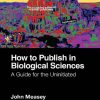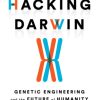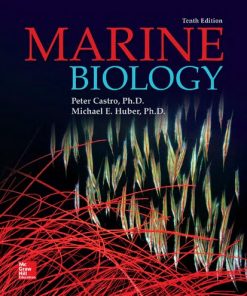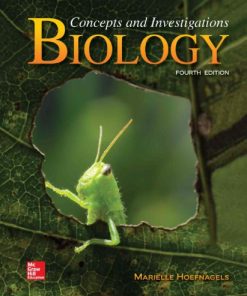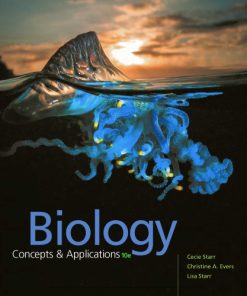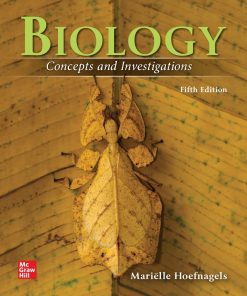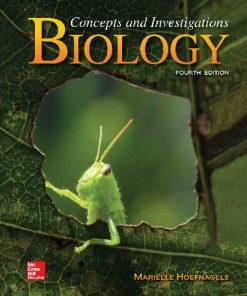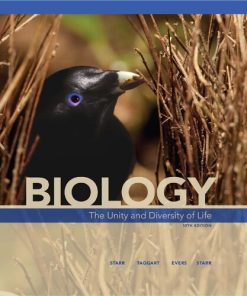(EBook PDF) Biology Concepts and Applications 10th Edition by Cecie Starr, Christine Evers, Lisa Starr 9798214338392 full chapters
$50.00 Original price was: $50.00.$25.00Current price is: $25.00.
Biology: Concepts & Applications 10th Edition by Cecie Starr, Christine A. Evers, Lisa Starr – Ebook PDF Instant Download/DeliveryISBN: 9798214338392
Full download Biology: Concepts & Applications 10th Edition after payment
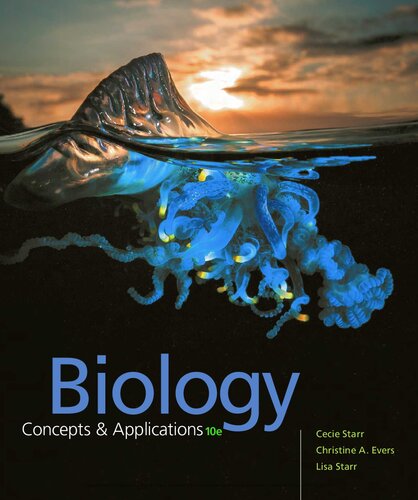
Product details:
ISBN-13 : 9798214338392
Author: Cecie Starr, Christine A. Evers, Lisa Starr
Should there be warning labels on fast foods? Should employers be allowed to require drug testing? This introductory text teaches you basic concepts of biology in context of critical issues. The Tenth Edition of BIOLOGY: CONCEPTS AND APPLICATIONS was developed in partnership with the National Geographic Society, known for its eye-opening photography and legacy of inspiring people. The result is a text that combines clear explanations with unparalleled visuals to introduce the process of science and core concepts of biology. “Engage” boxes help you see chapter concepts being put to work in the real world; “Learning Objectives” help focus your studying; “Applications” bring chapter content to real life; “Figure It Out” questions help you check understanding; and “Data Analysis” activities strengthen your analytical skills. This book is widely praised for clear and engaging writing, exceptional art, and terrific support from media that all work together to help you “get” biology.
Biology: Concepts & Applications 10th Table of contents:
1. The Science of Biology
1.1. Life Is More Than the Sum of Its Parts
Emergent Properties
Life’s Organization
1.2. Life’s Unity
Energy and Nutrients
Homeostasis
DNA Is Hereditary Material
1.3. Life’s Diversity
1.4. Organizing Information About Species
A Rose by Any Other Name . . .
Distinguishing Species
1.5. The Science of Nature
Thinking About Thinking
The Scientific Method
1.6. Examples of Experiments in Biology
Research in the Real World
Potato Chips and Stomachaches
Butterflies and Birds
1.7. Analyzing Experimental Results
Sampling Error
Bias
Objectivity
1.8. The Nature of Science
What Science Is
What Science Is Not
Application: Process of Science
The Secret Life of Earth
Chapter Summary
Self-Assessment
Class Activity: Data Analysis
Class Activity: Critical Thinking
Unit 1. Principles of Cellular Life
2. Life’s Chemical Basis
2.1. Building Blocks of Matter
Atoms and Elements
Isotopes and Radioisotopes
2.2. Why Electrons Matter
Electrons Have Energy
The Importance of Vacancies
2.3. From Atoms to Molecules
Chemical Bonds
2.4. Hydrogen Bonding and Water
Hydrogen Bonds
Water’s Special Properties
2.5. Acids and Bases
Hydrogen Atoms and pH
Application: Science & Society
Mercury Rising
Chapter Summary
Self-Assessment
Class Activity: Data Analysis
Class Activity: Critical Thinking
3. Molecules of Life
3.1. The Chemistry of Biology
Carbon, the Stuff of Life
Metabolic Reactions
3.2. Carbohydrates
Carbohydrates in Living Systems
3.3. Lipids
Lipids in Living Systems
3.4. Proteins
Building Proteins
From Structure to Function
3.5. The Importance of Protein Structure
3.6. Nucleic Acids
Application: Science & Society
Fear of Frying
Chapter Summary
Self-Assessment
Class Activity: Data Analysis
Class Activity: Critical Thinking
4. Cell Structure
4.1. What, Exactly, Is a Cell?
Cell Theory
Components of All Cells
Constraints on Cell Size
4.2. How We See Cells
4.3. Cell Membrane Structure
The Fluid Mosaic Model
Proteins Add Function
4.4. Introducing the Prokaryotes
Structural Features
Biofilms
4.5. Introducing the Eukaryotic Cell
General Features of Eukaryotic Cells
The Nucleus
4.6. The Endomembrane System
A Variety of Vesicles
Endoplasmic Reticulum
Golgi Bodies
4.7. Mitochondria
4.8. Chloroplasts and Other Plastids
4.9. The Cytoskeleton
Cytoskeletal Elements
Cellular Movement
4.10. Cell Surface Specializations
Extracellular Matrices
Cell Junctions
4.11. The Nature of Life
Life Is Squishy
Application: Science & Society
Food for Thought
Chapter Summary
Self-Assessment
Class Activity: Data Analysis
Class Activity: Critical Thinking
5. Ground Rules of Metabolism
5.1. Life Runs on Energy
Energy Disperses
Energy’s One-Way Flow
5.2. Energy in the Molecules of Life
Chemical Bond Energy
Why Earth Does Not Go Up in Flames
Energy In, Energy Out
5.3. How Enzymes Work
The Need for Speed
Influences on Enzyme Activity
5.4. Metabolic Pathways
Controls Over Metabolism
Electron Transfers
5.5. Cofactors
ATP—A Special Coenzyme
5.6. Diffusion and Membranes
Factors That Affect Diffusion
Osmosis
Turgor
5.7. Membrane Transport Mechanisms
Transport Protein Specificity
Passive Transport
Active Transport
5.8. Membrane Trafficking
Vesicle Movement
Membrane Recycling
Application: Interdisciplinary Science
A Toast to Alcohol Dehydrogenase
Chapter Summary
Self-Assessment
Class Activity: Data Analysis
Class Activity: Critical Thinking
6. Where It Starts—Photosynthesis
6.1. Overview of Photosynthesis
Autotrophs and Heterotrophs
Two Stages of Reactions
Where Photosynthesis Occurs
6.2. Sunlight as an Energy Source
Visible Light Drives Photosynthesis
To Catch a Rainbow
6.3. Light-Dependent Reactions
The Noncyclic Pathway
The Cyclic Pathway
6.4. Light-Independent Reactions
The Calvin–Benson Cycle
Photorespiration
6.5. Carbon-Fixing Adaptations of Plants
C4 Plants
CAM Plants
Application: Complex Systems
A Burning Concern
Chapter Summary
Self-Assessment
Class Activity: Data Analysis
Class Activity: Critical Thinking
7. Releasing Chemical Energy
7.1. Introduction to Carbohydrate Breakdown Pathways
Reaction Pathways
7.2. Glycolysis—Sugar Breakdown Begins
Glycolysis Reactions
Comparing Other Pathways
7.3. Acetyl–CoA Formation and the Citric Acid Cycle
7.4. Aerobic Respiration’s Big Energy Payoff
Electron Transfer Phosphorylation
Summing Up
7.5. Fermentation Pathways
Alcoholic Fermentation
Lactate Fermentation
7.6. Food as a Source of Energy
Energy from Dietary Molecules
Application: Interdisciplinary Science
Mitochondrial Malfunction
Chapter Summary
Self-Assessment
Class Activity: Data Analysis
Class Activity: Critical Thinking
Unit 2. Genetics
8. DNA Structure and Function
8.1. The Discovery of DNA’s Function
Early Clues
A Surprising Result
Final Pieces of Evidence
8.2. Discovery of DNA’s Structure
Building Blocks of DNA
DNA Sequence
8.3. Eukaryotic Chromosomes
Chromosome Structure
Chromosome Number
8.4. How Does a Cell Copy Its DNA?
Semiconservative Replication
Directional Synthesis
8.5. Mutations and Their Causes
8.6. Cloning Adult Animals
Application: Science & Society
A Hero Dog’s Golden Clones
Chapter Summary
Self-Assessment
Class Activity: Data Analysis
Class Activity: Critical Thinking
9. From DNA to Protein
9.1. Introducing Gene Expression
9.2. Transcription: DNA to RNA
Post-Transcriptional Modifications
9.3. RNA and the Genetic Code
The Messenger: mRNA
The Translators: rRNA and tRNA
9.4. Translation: RNA to Protein
9.5. Consequences of Mutations
Application: Interdisciplinary Science
The Aptly Acronymed RIPs
Chapter Summary
Self-Assessment
Class Activity: Data Analysis
Class Activity: Critical Thinking
10. Control of Gene Expression
10.1. How Cells Control Gene Expression
Switching Genes On and Off
10.2. Orchestrating Early Development
10.3. Details of Body Form
10.4. Gene Expression in Metabolic Control
The lac Operon
Lactose Metabolism in Mammals
Circadian Rhythms in Plants
10.5. Epigenetics
Application: Interdisciplinary Science
Between You and Eternity
Chapter Summary
Self-Assessment
Class Activity: Data Analysis
Class Activity: Critical Thinking
11. How Cells Reproduce
11.1. Multiplication by Division
The Cell Cycle
Mitosis Maintains the Chromosome Number
Control Over the Cell Cycle
Why Cells Divide by Mitosis
11.2. A Closer Look at Mitosis
11.3. Cytoplasmic Division
11.4. Marking Time With Telomeres
11.5. Pathological Mitosis
People also search for Biology: Concepts & Applications 10th:
biology of humans concepts applications and issues
biology concepts and applications pdf
biology of humans concepts applications and issues pdf
conservation biology foundations concepts applications
biology concepts and applications cecie starr
Tags:
Biology Concepts,Biology,Applications,Cecie Starr,Christine Evers,Lisa Starr
You may also like…
Biology and other natural sciences - Biology
Marine Biology 10th Edition by Peter Castro, Michael Huber 0078023068 978-0078023064
Biology and other natural sciences - Biology
Biology Concepts and Investigations 4th Edition by Mariëlle Hoefnagels 007802420X 978-0078024207
Biology and other natural sciences - Biology
Biology: Concepts and Applications 10th Edition by Cecie Starr 9798214338392
Biology and other natural sciences - Biology
Biology and other natural sciences - Biology
Biology Today and Tomorrow With Physiology 6th Edition Cecie Starr
Biology and other natural sciences - Biology
Biology and other natural sciences - Biology
Biology: concepts and investigations 4th Edition Mariëlle Hoefnagels
Biology and other natural sciences - Biology
Biology : the unity and diversity of life 15th Edition Cecie Starr


